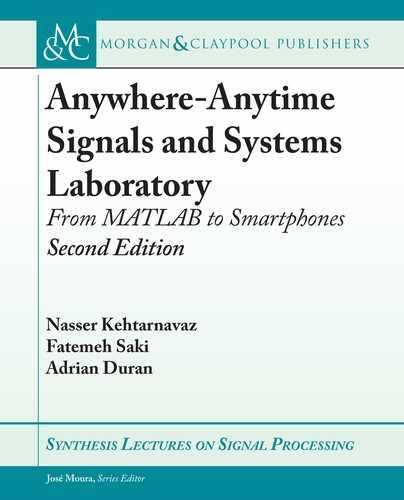
82 4. LINEAR TIME-INVARIANT SYSTEMS AND CONVOLUTION
Figure 4.25: L4_4_testbench for plotting x.t/, h1.t/; h2.t/, and y.t/ for choice 2.
After running L4_4_testbench, follow the steps in L4_1 to generate the corresponding
C code and then place it into the shell provided. Figures 4.26–4.35 show the app screen on an
Android smartphone as well as x.t /, h.t /, and y.t/ plots for different Delta. A desired plot can
be chosen from a choice picker located on the right side and by pressing the PLOT button.
L4.5 LINEAR CIRCUIT ANALYSIS USING CONVOLUTION
In this section, let us consider an application of convolution involving RLC linear circuits to
gain a better understanding of the convolution concept. A linear circuit is an example of a linear
system, which is characterized by its impulse response h.t/, that is, the output in response to a
unit impulse input. e input to such circuits can be considered to be an input voltage v.t/ and
the output to be the output current i.t/, as illustrated in Figure 4.36.
For a simple RC series circuit shown in Figure 4.37, the impulse response is given by:
h.t/ D
1
R
exp
1
RC
t
; (4.13)
which can be obtained for any specified values of R and C . When an input voltage v.t/ (either
DC or AC) is applied to the circuit, the current i.t/ can be obtained by simply convolving the

4.3. CONVOLUTION EXPERIMENTS 83
Figure 4.26: L4_4 Initial screen. Figure 4.27: L4_4 Plot of x.t/.

84 4. LINEAR TIME-INVARIANT SYSTEMS AND CONVOLUTION
Figure 4.28: Plot of h1.t /. Figure 4.29: Plot of h2.t/.

4.3. CONVOLUTION EXPERIMENTS 85
Figure 4.30: Commutative property. Figure 4.31: Commutative property.

86 4. LINEAR TIME-INVARIANT SYSTEMS AND CONVOLUTION
Figure 4.32: Associative property. Figure 4.33: Associative property.
..................Content has been hidden....................
You can't read the all page of ebook, please click here login for view all page.
